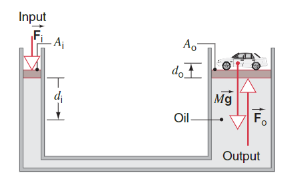Pascal’s Principles states that:
Pressure applied to an enclosed field is transmitted undiminished to every portion of the fluid and to the walls of the containing vessel.
If you increase the external pressure on a fluid at one location by
All of hydraulics operate using Pascal’s principle. It lets us amplify small forces to move massive parts.
Proving Pascal’s Principle
We will prove Pascal’s principle for an uncompressible liquid.

In this example, an external for
if the external pressure is increased by
Since the liquid is incompressible,
So, the change in pressure at any point in the fluid is equal to the change in external pressure, confirming Pascal’s principle.
Even though we have assumed that the liquid is incompressible in this case, Pascal’s principle is true for all fluids. For compressible fluids, a change in external pressure leads to a change in density, but the disturbance fades over time and the effect is the same.
The Hydraulic Lever

The Hydraulic Lever is an application of pascal’s principle. In this example, an external force
The pressure on the fluid from the small piston is
Since the ratio
Since the ratio